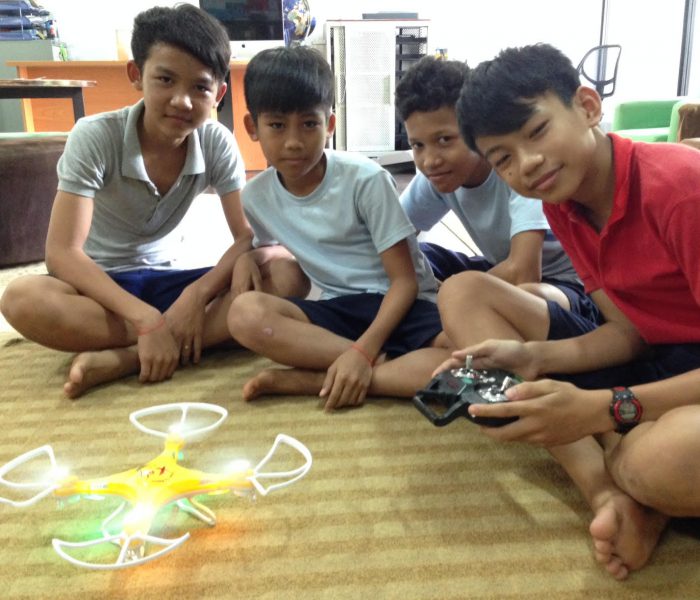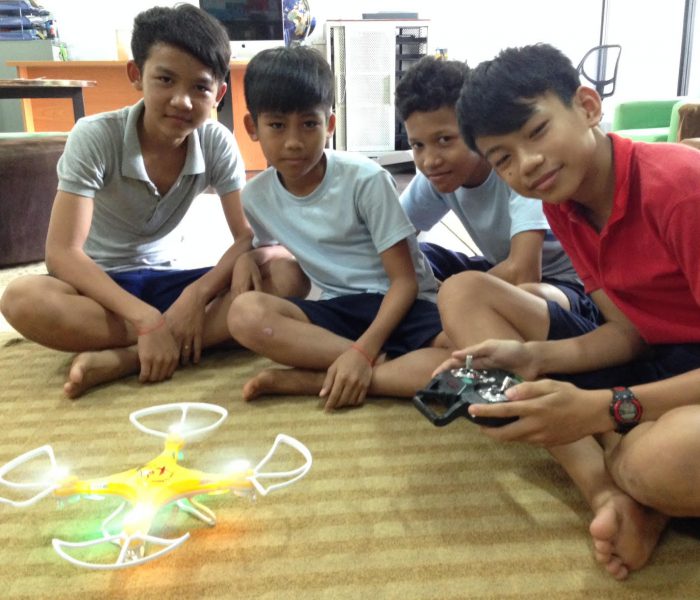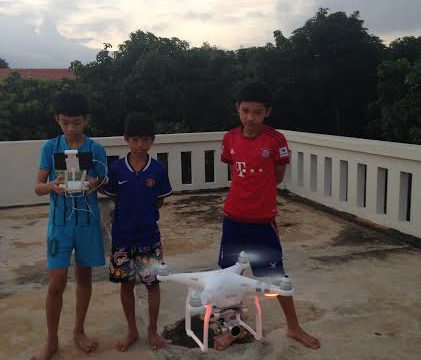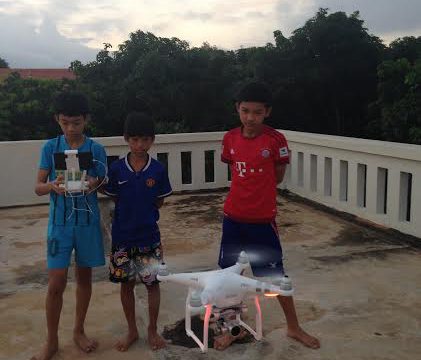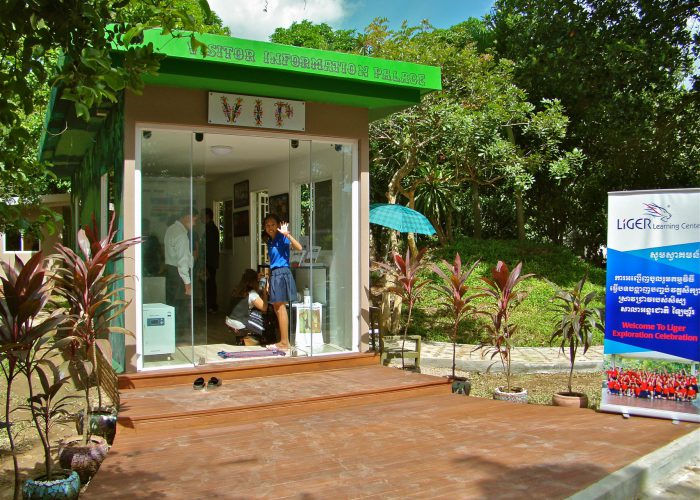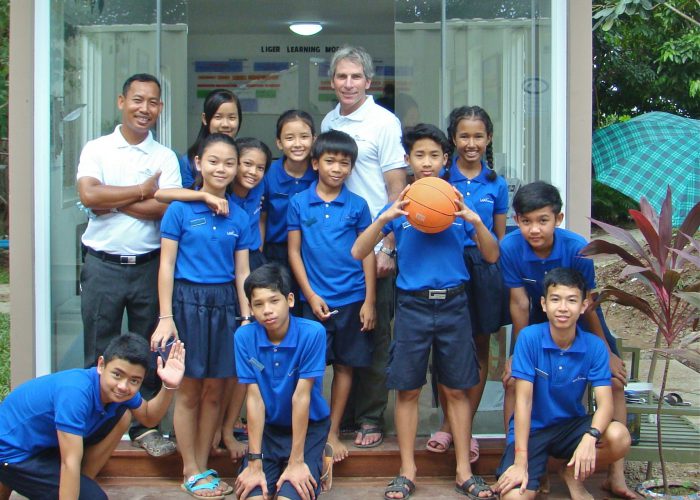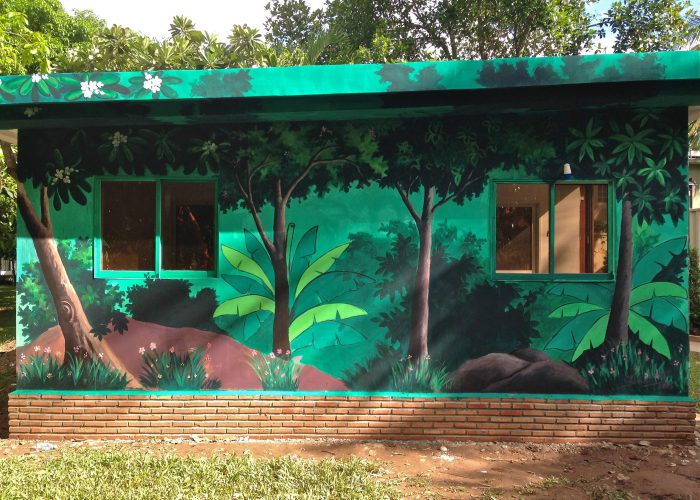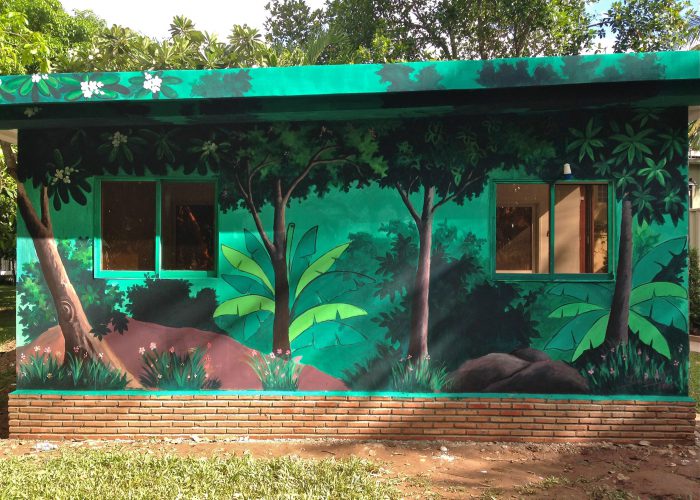In our drone exploration we were buy a cheap drone to practice while we were practice there were a lot of problem like we lost the gear and motor not work but we have a lot of experience with cheap drone so we buy the new drone that cost 1000$(DJI Phantom 3 Advance). We also do a lot of research about the drone and we compare them by price and quality which one that is better. In our drone group we also make a presentation that talking about drone to present to other people about drone.
Liger Visitor Information Palace construction finish
This is the Liger Visitor Information Palace that We use 7 weeks to finish it. Every eletronic thing in the Visitor Information Palace was run by solar. In the Visitor Information Palace we put the Liger model, The slide show that talking about Liger, and some of the product such as; hat, shirt, mug, keychain, water bottle and the Economic book that made by Liger students. In the VIP exploration I also learned about one of the software call Blender. We use Blender to design the building campus in Liger and print it by the 3D Printer so we can put the campus on our liger model.
Writing Sentences
I go to an unusual school. This school is called Liger Learning Center. This school is in Phnom Penh, Cambodia. We have 40 staff and 50 students. We have six core values such as; Integrity, Stewardship, Appreciation, Determination, Optimism and Ingenuity. We have something called, “explorations”. An exploration is where a group of students work with a teacher for seven weeks. We have different topics of exploration and some of them are Forest Ecology, Entrepreneurship, Animal Guide and others explorations.
Liger Visitor Information Palace under construction
First Exploration 2015/2016:
Visitor Information Palace
The BIG question
End goal for visitors, or what we want the visitor to have learned when they exit?
The goal of our Visitor Information Palace is to have people who are coming to the Liger Learning Center for the first time gain an understanding of what our campus looks like by our 3D model. They will also learn about the projects and explorations that we have been doing at Liger, through our slideshow pictures, video, the Animal Guide book, and the Cambodian Economy book. The video will explain the philosophy and history of Liger. There will also be a display explaining how solar energy is being used to power the VIP. The overall idea is to give visitors an idea of what the Liger Learning Center is about, both physically and spiritually.
The Liger Visitor Information Palace
-A 3D model of Liger (In the middle), with a key.
-A 150cm/75cm table for our model and a small table for exploration (Cambodia’s Wildlife -and Cambodia’s Economy books)
-Products from previous explorations (ex. T-shirts, mugs, bags and etc.)
-One or two wall fans.
-Two Monitors with video & slide show.
-Solar powered with a display.
-Picture of Liger from satellite (google earth)
-Pictures of the activities that Liger students are doing and have done.
-Liger pictures (students and staff)
-Trip pictures.
-Deck & landscaping (trails)

Create the Cambodia Wild Animal books
Something that I has changed Cambodia is make a book that talk about animal in Cambodia. In that book we has the information that talk about each animals and the picture for the animals we not take a photos of that animals or take it from the internet we paint the animals with a color painting. We were working with Art in a Box. We were try very hard to paint the pictures and find the information in our book. In our book we were write in Khmer and English because we want Cambodian and other people around Cambodia to read and know about Cambodia animals . We also go to visit a lot of expert to ask them the question about the animals in our books. We were go to see the breeding season of the bird at Prektoal flooded forest in Cambodia to get the information. There were 84 species and 7 Ecosystem in our book. We were try our best to get money to print the book for other people or student in Cambodia to learned about the animals in Cambodia. At the end we were get a lot information and we try to write our first draft. It were so hard for us to write the first draft at the first time but when we write a long time it make us get more experian to write the first draft and it make us write faster and faster. When our director Dom went to meet with the ministry of education he had talk to him about our book. When the ministry of education heard about our book he was said he will print the book and he will put it in many secondary school in Cambodia. He was said he will put 2 books of our book in each secondary school. We were so happy. That is how I had changing Cambodia.
My Economy class
Refuse Plastics Decription
Exploration Name: Refuse Plastics
Exploration Dates: May 5 2014 – june 17 2014
Number of Student: 12
Description: In this exploration we learned about type of plastics history of plastics reduce,reuse,recycle problem of plastic where do the plastics go and something of. We not just learned in the class but we also go to community, BKK market and luckey market to find out the answer. Problems with plastics waste ? Problems of Bury it can pollute the water and soil. Problems of Burn have Co2 mutation dangerous because smoke a lot when smoke a lot and people that driving is can’t see and it can crush together. Problem of throw on the road dangerous because when the wind blows the plastics to the eye of the driver they can be dangerous. Pollute the water when we throw the plastics into the water and the fish can live in the water can’t drink because pollute. Fish can eat the plastics waste because the fish is think the plastic is the food to eat. Can clog the drain and the water can’t going in to the clog and when it have the rain it will have the flooding people hard to go other places also it will have a lot of the mosquito and the people will have a lot of people is sick. problems of landfill take to much of the space,leaching chemicals because when it have a lot of rain the chemicals will spread out and go into the water. Methane gas it the organic waste in the landfill don’t have the O2 to compose it will make the methane gas is stronger than co2 about 21time. We also learned about 3R it mean to reduce reuse and recycle the plastics waste. Reduce is mean to use less plastics or not use plastics. Reuse is mean to use the plastics again. Recycle is mean to make something new. 5D it have define, discover, design, develop, and deploy. Define is mean to find the problem of the plastics. Discover is mean to learn about the problem. Design is meant to use it again to make something new like bag flower or other thing of. Develop is mean to make it better not have a lot of carmicle. Deploy is mean to teach other people about the plastic. We also go to community to find the community survey about the plastic and we as the people in community. We go to the BKK market and I find that the seller in BKK market is use a lot of plastic it can be up to 30 kg of plastic in one week. The Lucky market is not use a lot of plastic they just put something that they buy and put in one bag. cintri I learned that the plastic that cintri take from the community is have about 14000 tons – 15000 tons. Our group is have the solution to have less plastic in cambodia if we take the plastics to make something of like a bags, flower or other thing of. I hope that if all the people take the plastics that they throw away to make something like the bag or something that can use to do something and it will not go to landfill and cambodia is will have less plastic. One more thing I hope that people in cambodia is compost the plastics because it have up to 60% of rubbish in the landfill that not compost and if it not compost it will get to methane gas and it is dangerous than C02 about 21 time.
Biography Description
Exploration Name: Biography
Exploration Dates: August 12-September 26
Essential Questions:
(1) What is a biography?
(2) What events have shaped this person’s life?
Number of Students: 13
Description: The first day that we started to learn our Exploration everyone was very excited. Our Exploration studied with teacher Jo, Sambath and Channa. Our Exploration learned about Biography. Biography is studying about the other person’s life. Biography group worked together and shared ideas that we had. For example: we went on a trip and searched the information in computer. When we interviewed we used the strategy to understand about the other person’s life like listening strategy, asking questions and interviewing. We learned how to interview the people, by writing down the notes, how to be a good photographer and a good questionnaire. When we interviewed the people already we not just write down notes in our book. We also learned to make a documentary in the iMovie program. Some people worked on the information that they got too but they did it in Powerpoint program. The reason we wanted to do like this because in the future if we forget what we have we can look in the documentary of the other people life. The people that we interviewed were:Sophal’s uncle (the older person and now he does not do anything because his leg is hurt), Sophal’s sister-in-law (now she not do anything but she works at her house), Sophal (works in Liger cleaning the school), Simian (works in Liger cleaning the school) and Houy (also works at cleaning Liger too). We had many different people that we interviewed but we only give example some of the people. We took the trip to go to the pagoda near our school to interview the monks in that pagoda. It was so fun for the Biography group. Our group studied only six weeks. Every day during Exploration time the students worked hard and studied new things a lot. In this Exploration all of the students are not lazy, they are active and helpful. We all were really happy to study about biography and now help us have a knowledge and a lot of the experience that we thought.
TV Broadcasting Description
Exploration Name: TV Broadcasting
Exploration Dates: January 20th – March 7th
Number of Students: 8
Description: In the TV Broadcasting group we learned about how to be a good emcee, film, and about the different jobs. We divided into four jobssuch as producer, editor, cameraman, and emcee. A producer has to make a script for emcee. Also they have to make a storyboard and tell the cameraman what plot they want for the video. After all of this, they have to sit with the editor to tell what we want the video about. A editor also has a hard work to do. They have to make sure that the video is right and what they want. A cameraman has to go to take a video with the producer. Before the emcee talks in the real show they have to understand what the script is about. In our class we made one documentary about Liger. Before we made a documentary we took some trips to some TV stations and met with the producer. We went to the CTN channel station and Apsara channel station. We got a lot of experience from the emcee and the producer. It helped us a lot when we made our documentary.
Food Systems Description
Exploration 6
- Exploration Name: Food Systems
- Exploration Dates: March 10 – May 2
- Number of Students: 15
A food system is the cyclical process of growing, transforming, packaging, transporting, cooking, eating, and recycling food. Sometimes we can skip some of these steps. For example if we eat a mango that grows from a tree at our house we are skipping packaging, transporting, cooking, and transforming. This is an example of a local food system. An example of a global food system is chips that have ingredients from different parts of the world and are packaged, transformed and transported all over the world.
In our class we learned the difference between all three kinds of soil. They are sand, silt and clay. We started to grow the seeds. The seeds have grew, but we have not taken its to grow in our raised beds yet. In one day we have to give the water to the plants 3 – 4 times. We learned the six steps to grow the seeds, from laying the toilet paper to moving them in the tray. We have learned the part of the seeds. There are seed coat, embryo and cotyledons. We learned about the fruits and vegetables. We also learned about global and local food systems. Global is the food that is all around the world. Local is the food that is near. Ex: If we are Cambodian and buy the food in Cambodia that food is the local because it is near where we live. Ex: If we are Cambodian and buy the food from Malaysia that food is the global because it is far away from where we live. Also, we learn about the pros and the cons about local and global food systems.
We took four trips to learn about Food Systems. The first trip we went on Organic farm. The owner shown us how to grow the seeds. In his farm there are ten different typesof seeds: lettuce, fruit plants and herbs. Also, he told us that insects and the weeds destroy his farm. Weeds are the things that you don’t want. EX: In the farm have the grass that grows, the weeds is the grass because the farmer doesn’t want that to grow in their farm. New technology is that they cover the soil by the plastic because when we put the compost and the water will not go away. Compost is made out of the animals poo mixed with soil and rice husks. The second trip we went to Natural garden store. In that shop sell vegetables, snacks, wine and ingredients. The owner had taught us how to find where the food came from. The owner said that some of his fruits, vegetable and cookies are bought from France, America, Thailand, North America, Singapore, Germany and local. He has own farm in Kampong Speu and at Kampong Som. The third trip we went to University Agriculture. In there we learned about hydroponics. The guide told us that hydroponic is the new technology in Cambodia. Hydroponics means growing on the water. At there we saw lots of lettuce that grows on the water. The last trip we went to Rice Mill. We learned about the different rice in Cambodia. Also, we learned the difference between brown rice and white rice and how both of this rice is good for us.

